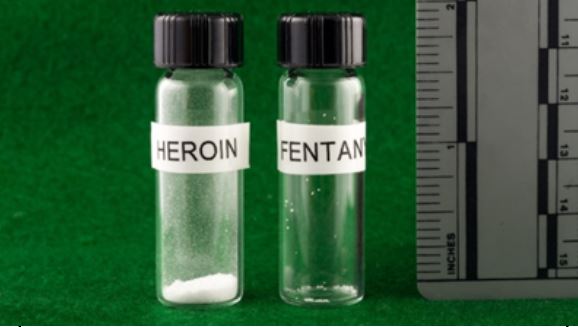Fentanyl – Deadlier than Heroin
Dr. Joseph E. Graas, Scientific Director
Dr. Edward Moore, Medical Director
Dr. Paul Robandt, Scientific Director
Fentanyl (also known as fentanil) is a short-acting opioid pain medication that is 50 to 100 times more potent than morphine.1 1,700 kilograms of fentanyl were used globally in 2013.2 Fentanyl is considered safe and has a wide therapeutic range, but only when carefully administered from dilute solutions.
Fentanyl is used for anesthesia and pain relief. Particularly when used for anesthesia, fentanyl is administered with a benzodiazepine such as midazolam. Fentanyl is also distributed in transdermal patches that may be prescribed for patients who require continuous opioid administration for chronic or severe pain that cannot be managed by other means. 3 Fentanyl is also absorbed well sublingually and may be administered in the form of lollipops or lozenges, in addition to intranasally.
Like heroin, morphine and other opioid drugs, fentanyl works by binding to the body’s opioid receptors, which are found in areas of the brain that control pain and emotions.4 When opioid drugs bind to these receptors, they can drive up dopamine levels in the brain’s reward areas, producing a state of euphoria and relaxation.4 Fentanyl’s effects resemble those of heroin and include euphoria, drowsiness, nausea, confusion, constipation, sedation, tolerance, addiction, respiratory depression and arrest, unconsciousness, coma, and death.
When pure compound is used, or it is compounded incorrectly, fentanyl can be very deadly. Compare the photo of lethal doses of heroin versus fentanyl in the photo below. 5

Fentanyl abuse, whether knowing or unknowing, has caused drug overdose deaths to skyrocket in recent years.6 Drug overdose remains the leading cause of death in people in the US under 50, with roughly 64,000 people dying in drug-related deaths in 2016. Fentanyl is increasingly involved in drug overdose deaths, up as much as 540% in the last three years.7 Drug overdoses in the US are killing more people than the HIV epidemic at its peak.
Classified as a Schedule II drug by the DEA decades ago, fentanyl was unregulated in China until only very recently. Clandestine Chinese labs sell fentanyl and analogues of fentanyl to smugglers and cartels, and have even branched out into the mail order business. Drug cartels learned that the manufacture and transport fentanyl was easier and delivered a higher profit margin than trafficking in conventional drugs. This, coupled with the downturn of the US illicit marijuana trade, caused the cartels to promote fentanyl distribution into the United States.
Analogues of fentanyl have been made for pharmaceutical markets, most notably alfentanil and sufentanil, for use in pain relief and heart surgery, respectively. Other synthetic analogues have been copied from research articles by clandestine labs. For example, ohmefentanyl is 6,300 times stronger than morphine and carfentanil is 10,000 times stronger than morphine. Both are available by mail order as “research chemicals” from China. Use of the latter to subdue terrorists in the Moscow theater hostage crisis in 2012 resulted in the death of 125 people.8 Terrorism experts are urging that states consider the possibility of the use of carfentanil as a weapon of mass destruction. Carfentanil is so toxic that the DEA has issued a safety bulletin to police and safety responders with recommendations as to how to recognize and safely handle drug substances that may contain carfentanil.9
In our next installment we will discuss the illegal analogues of fentanyl in more detail.
![]()
REFERENCES
- Drug Facts: Fentanyl. National Institute on Drug Abuse, US National Institutes of Health. June 2016. Retrieved 19 March 2017.
- Narcotic Drugs 2014. International Narcotics Control Board. 2015. p. 21. ISBN 9789210481571.
- FENTANYL TRANSDERMAL SYSTEM – Pharmaceuticals Group Mallinckrodt Inc. (Revised: 02/2011)
- Gutstein H, Akil H. Opioid Analgesics. In: Goodman & Gilman’s the Pharmacological Basis of Therapeutics. 11th ed. McGraw-Hill; 2006.
- New Hampshire State Police Forensic Laboratory photo 2016.
- Fentanyl linked to thousands of urban overdose deaths, Washington Post 8/15/2017
- The First Count of Fentanyl Deaths in 2016: Up 540% in Three Years, The New York Times, J. Katz, 2017
- The Moscow Theater Hostage Crisis: Incapacitants and Chemical Warfare, The Chemical and Biological Weapons Nonproliferation Program, Middlebury Institute of International Studies at Montery, November 4, 2002 (www.nonproliferation.org/the-moscow-theater-hostage-crisis-incapacitants-and-chemical-warfare/)
- Carfentanil: A Dangerous New Factor in the U.S. Opioid Crisis – US Drug Enforcement Administration, https://www.hsdl.org/?view&did=795829 (2016)
